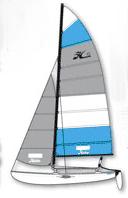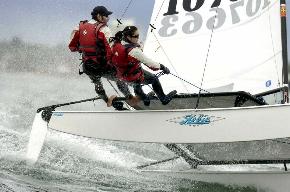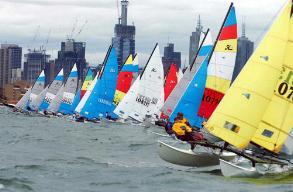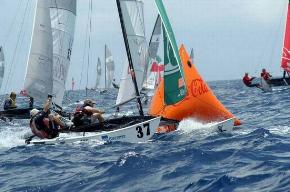

The first of four episodes of "As the Hulls Fly� will replace regularly scheduled programming starting tomorrow, and continue at indeterminate intervals over the next two weeks.
This Pre-Requisite Primer is for Non-sailors. The rest of you can just look at the pretty pictures.

The legendary design of the Hobie 16 was introduced in 1967, has been inducted into the Sailing Hall of Fame, and contributed to the over 100,000 Hobie Cats sailing around the world in huge Hobie fleets and regattas.
Powerful enough to challenge veteran sailors yet easy enough for beginners, the Hobie 16 is the perfect all-around cat. Asymmetrical hulls eliminate the need for dagger boards which makes for easy launching and beaching.
Specifications: (Please refer to drawing above)
Length: 16' 7"
Beam: 7' 11"
Mast Length: 26' 6"
Sail Area: 218 Sq. Ft.
Weight: 320 lbs.
Hull Construction: Fiberglass/Foam Sandwich
Hulls � The two long pointy floating colored things on either side of the boat. They are fiberglass, hollow, and coated with a product known as �gelcoat� which is very delicate, scratches, dulls, and is slick as snot when covered with water � the normal environment for hulls.
Trampoline � A two part mesh or canvas square between the two hulls. The two parts are laced together like a shoe in the middle with a 6-8 inch gap. As you sit suspended about 18 inches above the water, every wave pops up through the mesh/gap and hits you in face or the a*s. (see �Reasons to Own Wet and Dry Suits�)
Mast � The large 26� metal and wood pole on the front of the boat which holds up the sails and wires. The boat travels on a trailer with the mast DOWN (a beach cat is stored out of the water and launched off its trailer like a powerboat). The mast must be raised (stepped) before you sail. Grown men cry when trying to step it alone and have to be constantly reminded it is taller than most power lines. (Need I say more.)
Jib � The smaller sail on the front of the boat. It is attached to the boat with a metal line called a forestay ("stay" people) which runs from the top of the mast to the two wires coming out of the tips of the hulls (the bridle wires). When the boat capsizes the crew can �take a trip around the forestay� meaning you are swung from your side of the boat out and around the forestay, then dipped like a teabag while watching a 300 pound object head for your head. Sort of like a carnival ride but better. (see jibsheet)
Mainsail � The big sail in the middle of the boat. It is attached to the mast. A large metal pipe (boom) is then attached to the bottom. A sailboat cannot sail directly INTO or AWAY FROM the wind. It must sail at angles to the wind, moving forward by making a series of �Z�s in the direction you want to go. In other words, if you want to go 10 miles, you may sail 30 � left, tack (turn 45 degrees), right, tack, left. (see mainsheet). Some modern Hobies also sport �chutes� a triangular parachute type sail hoisted only when sailing downwind.
Boom � A VERY appropriately named large metal cylinder attached to the bottom of the mainsail. The boom runs the length of the boat and attaches in the back to the mainsheet (the rope, or line, that controls it). When the boat changes direction the boom swings from one side to the other knocking off anything that doesn�t duck. Thus a skipper must yell loudly �Tack� or �Jibe� which, translated, means �INCOMING!!�.
Tiller/Rudder Boards � The tiller is a long extendable aluminum pole attached to a bar which controls the rudder boards (one on the back of each hull). The tiller moves the rudder boards, which allow the skipper to steer by changing the way the water hits them. (like a powerboat motor, people)
Bridle Wires � A single wire attached to the front end of each hull. These wires meet in the middle and are hooked to the forestay � the wire which attaches the jib sail to the boat � forming a triangle at the front of the boat.
Forestay � The wire which runs from the top of the mast to the bridle wires at the front of the boat. The forestay also acts as one leg of the tripod which holds the mast up.
Shrouds � The two wires which run from the top of the mast to the side of each hull. These wires, along with the forestay, is what allows the mast to rotate and keeps it from falling over (they form a tight triangle). The shrouds are also good for holding onto when the hulls lift out of the water, and for getting tangled up in when trapping out (see Trap Wires). They also make for interesting bruises you can use to garner pity when telling a sailing story.

Trap Wires � The wires (two on a side) running from the top of the mast to a shock cord under the tramp. To keep the boat from capsizing, the crew and / or skipper, attach a hook hanging off the trap wire to a harness worn about the body. Holding onto their respective sheets and tiller, they step onto the slick as snot hull (trap out) as it lifts up to 10 feet in the air. This is called �flying a hull�. If the tip of the opposite hull goes into the water you will �take a trip around the forestay� and the boat will capsize on top of you, mast first. If you don�t grab it soon enough � the mast will turn to the bottom (known as turtleing). There have been instances of turtleing in water so shallow the wave action plows the mast into the sand or mud. Then you beg for help from a power boat (and they don�t like us cause water rules say sails win over power when faced with a right-of-way situation).
In race conditions you stay hooked to your trap wire at all times. As you tack (change direction) you must uncleat the sail, come into the boat, unhook the trap, hold and adjust the sail as it switches sides, scramble across the tramp avoiding the BOOM, cleat the sail, grab the trap hook on the other side, hook up, trap out, and pull the sail in tight as the boat swings round. You�ve got five seconds, give or take a second, until the skipper powers up the boat.
Mainsheet � The line that attaches to the back of the main sail, and goes through a set of cleats allowing the skipper to adjust speed and direction. The boat goes faster by moving the sail closer to the wind. The faster the boat goes, the more likely it is to fly a hull.
Jib Sheet � The line that attaches to the back of the jib sail, then goes through a double set of cleats (one on either side of the mast)allowing the crew to adjust speed and direction. If the jib stays cleated down when the boat capsizes the sail fills with water and it is impossible to right until it is uncleated.
Halyard � The wire that raises and lowers the sail.
Regatta/race - An event where lots of sailors and boats get together, hold several races, then finish off a keg of beer. All boats of the same size start at once, and are tagged with ribbons on their forestays for class. �A� class is most experienced, and �C� class is the beginners. Each size start is within five minutes of the last start ("C" class is sometimes started first because they are the slowest). Which can put a lot of boats on the course at once - each sailing a different course.
The first size lines up behind the start line (see picture #1 below) which runs from the course boat to a mark (big colored floating triangle). The course boat posts a course � what series of marks in what order you must go around. (see picture #2 below for boats rounding a mark). The first boat in each size and class to cross the finish line (usually the original start line) wins that race. The average of each finish placement determines the winner in each size/class. You can win your class and be an overall winner for size.


Stay tuned tomorrow for the first episode of "As The Hulls Fly"
To read all episodes in this series:
 |
| Get Your Own Map | View Larger Map |